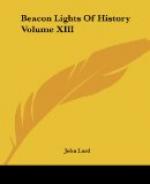With a secure and settled income, Scott now meditated a literary life. A hundred years ago such a life was impossible without independent means, if a man would mingle in society and live conventionally, and what was called respectably. Even Burns had to accept a public office, although it was a humble one, and far from lucrative; but it gave him what poetry could not,—his daily bread. Hogg, peasant-poet of the Ettrick forest, was supported in all his earlier years by tending sheep and borrowing money from his friends.
The first genuine literary adventure of Scott was his collection of a “Scottish Minstrelsy,” printed for him by James Ballantyne, a former schoolfellow, who had been encouraged by Scott to open a shop in Edinburgh. The preparation of this labor of love occupied the editor a year, assisted by John Leyden, a man of great promise, who died in India in 1811, having made a mark as an Orientalist. About this time began Scott’s memorable friendship with George Ellis, the most discriminating and useful of all his literary friends. In the same year he made the acquaintance of Thomas Campbell, the poet, who had already achieved fame by his “Pleasures of Hope.”
It was in 1802 that the first and second volumes of the “Minstrelsy” appeared, in an edition of eight hundred copies, Scott’s share of the profits amounting to L78 10 s., which did not pay him for the actual expenditure in the collection of his materials. The historical notes with which he elucidated the value of the ancient ballads, and the freshness and vigor of those which he himself wrote for the collection, secured warm commendations from Ellis, Ritson, and other friends, and the whole edition was sold; yet the work did not bring him wide fame. The third and last volume was issued in 1803.
The work is full of Scott’s best characteristics,—wide historical knowledge, wonderful industry, humor, pathos, and a sympathetic understanding of life—that of the peasant as well as the knight—such as seizes the imagination. Lockhart quotes a passage of Scott’s own self-criticism: “I am sensible that if there be anything good about my poetry, or prose either, it is a hurried frankness of composition, which pleases soldiers, sailors, and young people of bold and active dispositions.” His ability to “toil terribly” in accumulating choice material, and then, fusing it in his own spirit, to throw it forth among men with this “hurried frankness” that stirs the blood, was the secret of his power.
Scott did not become famous, however, until his first original poem appeared,—“The Lay of the Last Minstrel,” printed by Ballantyne in 1805, and published by Longman of London, and Constable of Edinburgh. It was a great success; nearly fifty thousand copies were sold in Great Britain alone by 1830. For the first edition of seven hundred and fifty copies quarto, Scott received L169 6 s., and then sold the copyright for L500.




